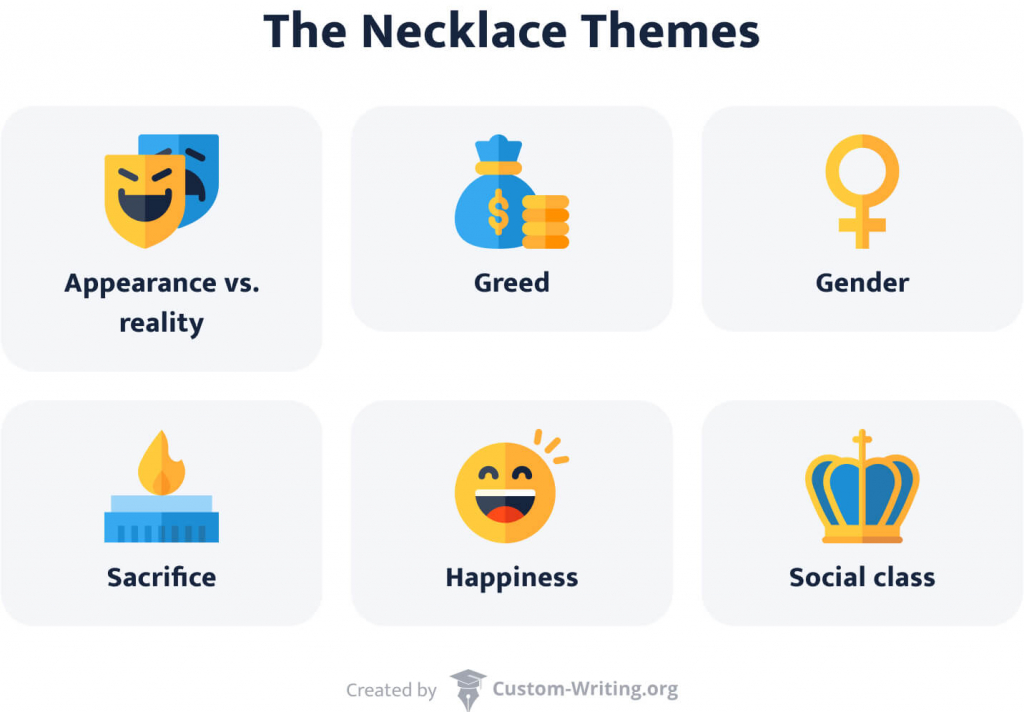Written at the end of the 19th century — the period marked by limited social mobility and poor opportunities for women — “The Necklace” explores themes that are both timeless and deeply rooted in its era. The short story by Guy de Maupassant discusses social class struggles, gender roles, illusions, and happiness. However, the key theme of “The Necklace” is greed, which impacts the main character’s downfall and highlights the dangers of valuing material wealth over contentment.
In this guide prepared by custom-writing experts, you’ll find:
- An overview of “The Necklace” themes
- A thorough analysis of each theme
- Quotes from “The Necklace” about greed as well as other themes in the short story
Themes in The Necklace: An Overview
The short story “The Necklace” is full of interesting themes that are worth discussing:

- Appearance vs. reality is the story’s central theme. It’s reflected through the image of a diamond necklace, which turns out to be fake.
- Greed is the story’s driving force. It prompts the main character, Mathilde, to borrow the piece of jewelry, which causes her downfall.
- Gender roles and expectations of 19th-century women also play an essential role. For Mathilde, beauty is her only tool, which is another reason the necklace attracts her.
- The theme of sacrifice refers to the main character giving up her comfortable lifestyle to pay for the necklace.
- Happiness is the theme that highlights the importance of perspective when it comes to being satisfied in life.
- The social class into which Mathilde was born confines her to a life of mediocrity. She knows that only a miracle would make her rich, so she ends up pretending to be upper-class.
Appearance vs. Reality in The Necklace
In “The Necklace”, the author highlights that appearance is often distinct from reality. The main character, Mathilde Loisel, seems to have trouble distinguishing between those. From the very beginning, she fantasizes that the world of wealthy people drastically differs from the one she lives in. Unlike his wife, Monsieur Loisel doesn’t daydream. Her husband enjoys the soup on the table while she dreams of exquisite dishes.
The impression that her appearance is an indicator of belonging to high society haunts her all her life. She dreams that her good looks and charm will lead her to a wealthy life. Her perception of wealthy people is enough for Mathilde to consider herself one of them.
The night at the ball turns out to be the best night of her life. Even though that night turns her life upside down for the next ten years, she believes she is in the right place. Yet, she only looks like those people without actually being one of them.
After losing the necklace, the main character decides to withhold the information about the loss from its owner. This lie then becomes the main reason for her problems. Mathilde tried so hard to appear wealthy and respected using her appearance that she lost her good looks completely when reality had hit.
Maupassant describes poverty and harsh reality, in which Mathilde and her husband ended up after buying the necklace, with great detail. This description is opposed to the depiction of the ball. The night of the ball was like a dream come true for the main character. Yet, it was a dream turned into a catastrophe.
By the end of the story, Mathilde meets Madame Forestier, who lent her the necklace. From the conversation, Madame Loisel learns that the diamonds were fake. The fakeness shows Madame Forestier in a different light. While the main character believed that people of higher social class are wealthy, her friend thought differently. It was the illusion that the appearance of wealth heavily relied on. Being rich is less crucial than appearing wealthy to others.
Quotes about Appearance vs. Reality
No . . . there’s nothing so humiliating as looking poor in the middle of a lot of rich women.
The Necklace, Mathilde Loisel
She suffered endlessly, feeling herself born for every delicacy and luxury. She suffered from the poorness of her house, from its mean walls, worn chairs, and ugly curtains. All these things, of which other women of her class would not even have been aware, tormented and insulted her.
The Necklace, Narrator
He threw over her shoulders the garments he had brought for them to go home in, modest everyday clothes, whose poverty clashed with the beauty of the ball- dress. She was conscious of this and was anxious to hurry away, so that she should not be noticed by the other women putting on their costly furs.
The Necklace, Narrator
Madame Forestier, deeply moved, took her two hands. “Oh, my poor Mathilde! But mine was imitation. It was worth at the very most five hundred francs!
The Necklace, Madame Forestier
The Necklace Theme of Greed
Greed and how it can lead to one’s downfall is the central idea of “The Necklace”. The problems in the story are related to the main character’s desire for wealth and luxury. Mathilde is unhappy with her life, mostly due to her social and financial status. She believes that she is in the wrong place and wishes for more.
But why? What are the reasons for her desire for material objects? Madame Loisel is not poor from the start of the story. Yes, she and her husband live quite modestly, but they have all the necessary aspects for a good life. So, why does the main character have so much greed? Why do her desires don’t comply with her abilities?
Already at that time, people dreamt of things out of their financial reach. Instead of enjoying the comfort of the possessed, people wanted something more expensive. Maupassant provides a clear example of that in the story. When choosing accessories for the ball, Mathilde could buy cheap flowers to look more fashionable. However, she decided against it. Flowers weren’t visibly expensive.
Another example concerns the price of the dress. Madame Loisel asked for 400 francs for an evening dress to go to the ball. That was an exact amount of money Monsieur Loisel has been saving. The objects have equal monetary value, yet choosing how to spend the funds reflects a person’s moral and social values. Buying a dress is an irrational choice. Yet, Mathilde does it to look wealthier in the eyes of the others.
Additionally, Mathilde has pride and ambition. Her beauty absorbs her. Her concentration on her appearance makes her disgusted with her current life. She truly believes that with her appearance, having no luxury and wealth is beneath her dignity.
Lastly, her desire for wealth is highly dependent on the role of women in society. Women were seen as decoration. Therefore, a woman was supposed to be in the place in compliance with her womanly virtues. Mathilde, in her opinion, was in the wrong place. That means that she wasn’t fulfilling her primary female function, influenced by the society of the 19th century.
Quotes from The Necklace That Show Greed
Check out the most prominent “The Necklace” quotes about greed below:
“I’m utterly miserable at not having any jewels, not a single stone, to wear,” she replied. “I shall look absolutely no one. I would almost rather not go to the party.”
The Necklace, Mathilde Loisel
She came to know the heavy work of the house, the hateful duties of the kitchen. She washed the plates, wearing out her pink nails on the coarse pottery and the bottoms of pans. She washed the dirty linen, the shirts and dish-cloths, and hung them out to dry on a string; every morning she took the dustbin down into the street and carried up the water, stopping on each landing to get her breath. And, clad like a poor woman, she went to the fruiterer, to the grocer, to the butcher, a basket on her arm, haggling, insulted, fighting for every wretched halfpenny of her money.
The Necklace, Narrator
Suddenly she discovered, in a black satin case, a superb diamond necklace; her heart began to beat covetously. Her hands trembled as she lifted it. She fastened it round her neck, upon her high dress, and remained in ecstasy at sight of herself.
The Necklace, Narrator
…she imagined delicate food served in marvellous dishes, murmured gallantries, listened to with an inscrutable smile as one trifled with the rosy flesh of trout or wings of asparagus chicken.
The Necklace, Narrator
The Necklace Theme of Gender
The theme of gender in “The Necklace” is mainly represented through the livelihood struggles of the main character. Mathilde, an elegant and beautiful woman, is confined to 19th-century gender expectations.
Back then, beauty was the only thing required from women. According to the story, it was “their sole hierarchy, making shopgirls the equals of the grandest ladies.” However, fate failed Mathilde, and she never married into wealth. Instead, her husband could only afford a humble existence.
She dressed plainly because she could not dress well, but she was unhappy as if she had really fallen from a higher station; since with women there is neither caste nor rank, for beauty, grace and charm take the place of family and birth.
The Necklace, Narrator
The social and political circumstances were the forces that were almost impossible to overcome for women back then. Mathilde can’t work, but she also can’t enjoy her friends’ lavish lifestyle of dancing, art, and music. While chasing her dreams, she becomes trapped in an even worse living situation because she needs to pay off her debts.
Sacrifice Theme in The Necklace
Mathilde and her husband sacrifice every piece of their fairly comfortable life for nothing. In the final part of the story, they are pictured living in borderline poverty since they have to pay off the price of the lost necklace. Ironically, Mathilde thought the necklace would make her happier, but instead, it forced her to sacrifice everything she had.
Thereafter Madame Loisel knew the horrible existence of the needy. She bore her part, however, with sudden heroism. That dreadful debt must be paid. She would pay it. They dismissed their servant; they changed their lodgings; they rented a garret under the roof.
The Necklace, Narrator
Another character conveying the theme of sacrifice in “The Necklace” is Monsieur Loisel, Mathilde’s husband. He’s the one to give up on all the savings to buy a new dress for his beloved wife. He’s also forced into living “the horrible life of necessity” because of her. Despite all this, he remains an honorable and loving spouse.
The Necklace Theme of Happiness
Maupassant’s story “The Necklace” truly shows how relative happiness is. Initially, Mathilde is dissatisfied with her life. She believes that wealth will make her happier. However, she chooses a dubious method of making her dreams come true.
Borrowing jewelry to pretend to be rich wasn’t a shortcut to wealth but to poverty. Mathilde starts to appreciate her former existence what she has when she loses everything.
She had no gowns, no jewels, nothing. And she loved nothing but that. She felt made for that. She would have liked so much to please, to be envied, to be charming, to be sought after.
The Necklace, Narrator
The author points out that happiness doesn’t necessarily depend on material possessions. This is especially evident in the example of Mathilde’s husband. Instead of making a sour face at their life circumstances, he says: “I don’t know anything better.” He is content with his socioeconomic situation and doesn’t need more luxuries to be happy.
Social Class in The Necklace
The theme of social class in “The Necklace” is very specific to the times when the story was written. Back then, people had to live the life they were born into and rarely had a chance to advance their social position.
Just like that, Mathilde is forced into the middle class, striving to enter higher social circles. Nothing she does would ever make her genuinely wealthy, which is the reason for the story’s main conflict. In the end, she decides to fake a higher social status instead. Mathilde sacrifices her modest yet comfortable life for one moment of glory while wearing the borrowed necklace.
Now, you know everything about the symbolism in “The Necklace” by Guy de Maupassant. Feel free to come back here when you need to refresh any specific details in your memory. If you need some inspiration for an essay about the story, check out our list of topics and samples.











